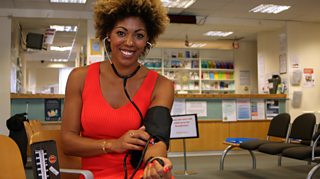Should I monitor my blood pressure at home?
Many of us are keen to monitor our health at home and companies are keen to sell us all sorts of gadgets to help us do so – but which (if any) are really worth buying?

91热爆 blood pressure monitors are increasingly popular – but are they accurate and how should they be used?
What is blood pressure?
Your blood pressure provides lots of information about how well your heart is working, as long as you interpret it correctly.
Blood pressure is the force that our blood exerts on our vessels as it circulates around the body and we measure both the highest (systolic) and lowest (diastolic) pressure. The systolic part indicates the pressure as our heart beats, and the diastolic is the pressure in between every heart beat. A healthy blood pressure should have a systolic reading of between 90 – 120 mmHg (‘millimetres of mercury’) and a diastolic reading between 60 – 80 mmHg. You may be used to seeing these figures written like this: 120/80 or said like this: 120 over 80 (that is the systolic pressure ‘over’ the diastolic pressure).
If you have a blood pressure reading outside of these ranges than it could mean a number of things.
High blood pressure can be an indicator that you have an increased risk of heart failure, stroke and other health conditions. On the other hand, a blood pressure that is too low can cause problems like fainting and may be an indicator of an underlying health condition.
But there are things that you can do to correct your blood pressure, so it is worth knowing.
Although knowing our average blood pressure can be very useful, it varies a lot, and so measuring it can be difficult.
For some people, physically being in a doctor’s surgery can make them anxious enough to increase their blood pressure. This is often referred to as “White Coat Hypertension” (named after the white coats doctors used to wear, and ‘hypertension’ being the term for high blood pressure). This is one good reason why taking your blood pressure at home could be a good idea.
But are these home blood pressure monitors accurate?
If you do want or need to buy a monitor, there are plenty on the market, but not all are accurate. The British Hypertension Society have tested and validated various blood pressure monitors and have listed them online. (See link at the end of this article).
If you are buying a blood pressure monitor from your pharmacist, you can also ask them to compare the result to their own calibrated machine, or bring it to your doctor’s surgery to be tested.
How should blood pressure be measured?
It is also very important to take your blood pressure properly, or you could get very misleading results. Your blood pressure is very variable, so you need to avoid anything that can make it unusually high.
Firstly, make sure you are comfortable. Sit down, with your back supported and your legs uncrossed.
Because digestion diverts blood to the gut, make sure that you haven’t just eaten a full meal or had coffee or smoked in the last 30 minutes as caffeine and nicotine can also have an effect.
Wear a loose fitted top so you can roll up the sleeve without putting too much pressure on your arm.
Put the cuff on following the instructions with your machine. Place your arm in a position where the cuff is at the same level as the heart (if you are wearing a wrist monitor, that is particularly important) and support your arm with a pillow or table if needed.
Relax for a few minutes to allow your blood pressure to settle. Don’t talk, and don’t hold your breath.
Then press the button and make a note of the reading.
It is best to take at least two readings at least a minute apart and average them. For a true average of your blood pressure, take it at the same time over 4 days and average the results. Your blood pressure may be slightly different in each arm, so you should use the same arm if possible.
Remember, if you are concerned about your blood pressure being too high or too low, keep track of your readings and talk to your doctor.
Things that can help lower your blood pressure include exercise, boosting potassium levels (through eating more vegetables), or – if necessary – medication.
-
![]()
Can garlic, watermelon or beetroot reduce blood pressure? We put the claims to the test.
-
![]()
Michael Mosley investigates whether cutting back on salt really improves our health.




























